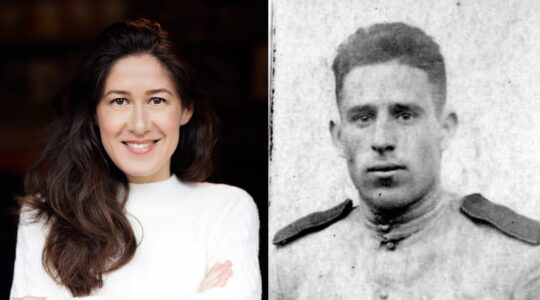Since the early 2000s, employment of ultra-Orthodox women in Israel has continuously been on the rise and has now reached 80 percent—or 5 percent higher than the general rate of women’s employment. What caused such a radical female rush to the workforce?
The motive was dire necessity. Since 2003, hareidi families have been confronted with reductions in child allowances—a measure clearly geared toward not only cutting state expenditures, but also incentivizing the hareidi community to introduce some changes in its structure. Indeed, however insular the hareidi community may be, those numbers testify to the policies’ capacity to affect them.
However, when trying to interpret those numbers in light of their impact on gender dynamics in religious society, we are puzzled indeed. Have we not been taught that women’s emancipation can be expected to correspond to their level of literacy and employment? According to those principles, hareidi women would be among the most emancipated in Israeli society.
Such a reading, though, runs counter to the general portrayal of ultra-Orthodox society outside its strictly defined borders. Indeed, the ultra-Orthodox leadership is often called out for its misogynistic hashkafah (worldview)—from erasing women’s faces in newspapers to forbidding women access to leadership positions in hareidi political parties.
Do those numbers indicate hareidi women’s independence, or testify to their double penalty—having to bear all the responsibility for the household’s wealth, while having little or no power within the home and inside their communities? These figures challenge our general assumption of what constitutes women’s emancipation and the tools needed to evaluate it.
Changes in Choice of Profession
Another change—more subtle and less easily quantifiable—has been in the type of professions hareidiyot (ultra-Orthodox women) choose. In the past, hareidiyot were often confined to caretaking positions such as nursing, midwifery, and pedagogy. Those areas of employment quickly became saturated as more women joined the workforce, pushing them to seek work outside areas of predefined gender expectations. Consequently, hareidiyot are now to be found in positions of power and high social prestige.
How is this change been accounted for and received in the hareidi community? Browsing through the press, one can hardly avoid both hareidi apologetics and hareidi bashing. What is certain, however, is that in most cases, the sources of information and judgment about women’s status within ultra-Orthodoxy are provided by outsiders: Hareidi women are proclaimed free or chained in the view of non-hareidi men or women.
However, if one turns to hareidi women to record their own understandings and self-perception, it is no simple task. One of the very distinctive traits of ultra-Orthodoxy is seclusion from broader secular society. If approaching these women as a non-hareidi wasn’t difficult enough, one can also challenge the genuineness of the answers provided to an outside pollster. Indeed, the hareidi community may very well be insular and careful not to expose internal struggles to the outside world. Moreover, gender mixing is highly frowned upon, so, in practice, only female journalists or sociologists can get a chance to approach those women and reach the level of trust required to have them share such intimate information.
Nevertheless, a few hareidiyot have started to make public appearances and become known figures outside their community. Their presence in the media is very much welcome in many respects. As mentioned earlier, seldom do we hear from hareidiyot themselves, but the benefit of their fame goes beyond providing the secular community with a spokesperson from an insular group. Young hareidiyot now have role models to look up to. Thankfully, we have now reached a point at which those figures no longer stand as isolated—and thus ostracized—characters in the hareidi sector, but constitute a real pool of women who, while remaining ultra-Orthodox in their practice, have excelled in a wide range of professional careers outside the hareidi world.
Thankfully, we have now reached a point at which those figures no longer stand as isolated—and thus ostracized—characters in the hareidi sector, but constitute a real pool of women who, while remaining ultra-Orthodox in their practice, have excelled in a wide range of professional careers outside the hareidi world.
Let us examine a few examples of this trend in Israeli society, each with an analysis of the hareidi narrative of their achievements and their justification.
Judge Havi Toker
In February 2018, Havi Toker was appointed as the first female ultra-Orthodox judge to serve in the Jerusalem Magistrate’s court—and, interestingly, the news received laudatory treatment from the hareidi press. Kikar Shabbat, an Israeli hareidi news website, referred to Judge Toker as a “pioneer.” Not only did the very usage of the term “pioneer” clearly testify to a will to encourage others to follow Judge Toker’s path, it was also a signal of a new understanding of the potential impact of female labor. The approval by a mainstream hareidi medium is very significant: A large part of the hareidi community sees in these women the opportunity to foster the broader community’s interest in the state’s institutions. Rather than needing to be sheltered from the outside world, women can be useful in bringing hareidi interests to the secular table.
Political Participation
Women are still nowhere to be found in hareidi political parties such as Shas (the Sephardi hareidi party), Agudat Yisrael, and Degel haTorah, which are, respectively, the hasidic-oriented and non-hasidic Ashkenazic hareidi parties. When combined, these three are known as United Torah Judaism. However, hareidiyot are increasingly present in the political sphere. At present, although no hareidiyah has entered the Knesset under a religious party banner, a handful of women have contested the status quo both from within the structure of those parties and by creating their own party as a protest.
At present, although no hareidiyah has entered the Knesset under a religious party banner, a handful of women have contested the status quo both from within the structure of those parties and by creating their own party as a protest.
Already in 2014, animosity grew between Adina Bar Shalom, the daughter of Rav Ovadia Yosef, z”l, the founder of Shas and the party’s then leader, as a result of which the Shas leadership promised to establish a women’s council, but they did not mention allowing women to run for the Knesset. Ms. Bar Shalom was followed closely in her attempt by Raheli Ebenboim, a mother of three and a resident of Mea Shearim, who is married to an avreikh (a full-time Torah student). Even though Ms. Ebenboim withdrew before the election, she started a leadership program for hareidiyot aiming for university careers. Beginning a few years ago, Michal Zernowitski, Esty Shoshan, and Estee Rieder-Indursky have been attempting to convince rabbis of the necessity of women’s political representation and its halakhic legitimacy. Ms. Shoshan and Ms. Rieder-Indursky co-founded Nivharot, a movement whose slogan can be translated as “No vote without representation,” calling on women to stop voting for parties that refuse to give them a voice.
In the spring 2019 Knesset elections Michal Zernowitski made news by entering her name on the Labor list, saying that Labor’s platform of social justice, equality, and peace would appeal to hareidiyot like herself. She is far down enough on the Labor list, however, that it is highly unlikely that she would make it to the Knesset.
Similarly, in 2015, Ruth Colian, a 33-year-old mother of four, founded her own platform to foster ultra-Orthodox female representation in the Knesset. In an interview given to the Jerusalem Post in 2015, Ms. Colian justified her fight in these terms: “As hareidi women, we are slaves, we are invisible, we are the weaker sector. … There is a vast number of different population sectors who have representation in the Knesset—Arabs, Jews, Sephardim, Ashkenazim, hareidim, and so on. But hareidi women have no representation at all. There are male hareidi representatives, but they do not address the needs and concerns of hareidi women.”
Indeed, the findings on the health of hareidiyot are alarming: These women have “one of the lowest levels of life expectancy in the country, when hareidi men rank second.” During a hearing in the Knesset on the matter, Ms. Colian pointed out, no male hareidi MK attended.
Running a Marathon for God
In a different realm entirely, a hareidi mother of five was the winning woman in the 2018 Jerusalem marathon while seven-and-a-half months pregnant. This victory should not be deemed merely a miscellaneous news item, as the obstacles for hareidiyot to pursue sports activities are numerous. Women’s clothing is strictly regulated, according to the principles of tzniut. From collarbone to elbows and down to the knees, every inch of skin must be covered, as well as hair for married women. Pants are prohibited. These restrictions somewhat complicate access to certain sports.
The treatment that this marathon victory received in the Orthodox media is worth analyzing. In an article published on Jewinthecity.com, the journalist took great care not to frame this sports endeavor as a feminist one, but rather as a religiously motivated activity: The winner, Beatie Deutsch, claimed she was “running for a higher purpose” and had “raised money for two initiatives.” The journalist stressed the empowering impact this run has had on young women wanting to train while adhering to rules of modesty. “Deutsch has been approached by girls who thank her for normalizing working out in a skirt.” Another interesting point of the narrative was the necessity to argue that the beneficiaries of her running activity were eventually her family and not herself: “My kids know they are my number one priority. … Running is a very healthy outlet. … I’m naturally a type-A, competitive person and I don’t want that in my household. … I’m able to be more relaxed and calm with my family and kids.”
Whatever activity a hareidi woman may be engaged in, it can be sanctioned only within the accepted hierarchy of values in which family and strict observance takes precedence. Hence, the article concludes by portraying how Ms. Deutsch’s life returned to normalcy through a clear reference to Shabbat and domestic tasks. The runner stated, “The marathon was on erev Shabbos. After it, we had to get back and get the house clean and all that.”
Hareidi Women and Army Service
If service in the Israeli army still seems to be beyond the pale for hareidi women, the religious population is nonetheless undergoing a major shift in attitude: “The number of observant women serving in the IDF has soared by nearly 190 percent this decade,” claims Ha’aretz.
Most observant young women are signed up by their religious high schools for (noncombat) national service, but Sharon Brick-Deshen is fighting to offer young women a choice. Hence, she founded Meshartot Be’emunah (Serving with Faith), a program that educates religious women interested in the army and offers them the tools to remain religious during their army service. The fear that military service will cause young women to leave the religious fold is the primary concern cited in Orthodox milieus for discouraging their enlistment. Rabbi Yigal Levinstein, who heads the Bnei David pre-military academy in Eli, has aroused media attention for his homophobic statements and his stance against women in the military. He claimed, “They [the IDF] recruit them [women] to the army, where they enter as Jews, but they’re not Jews by the time they leave.”
R. Levinstein’s colleague, Rabbi Eli Sadan, founder of the Bnei David academy, has claimed that service can jeopardize women’s fertility, and that by accommodating women, the army is forced to compromise its standards of excellence.
One can understand why the pushback would be stronger against army service than for medical or legal careers. Use of force and mastery of warfare are deeply associated with masculinity. Moreover, among the recurring patterns of hareidi justification for allowing women to enter certain professions is the absence of negative impact on what remains their main priority: motherhood. However, such a defense is challenging for a pursuit that requires a long time spent on a military base far from home.
Consequences of Empowerment
The very structure of hareidi gender roles in the household, with the husband remaining within the community to study Torah full-time while the wife works to sustain the family, has led some women to cross the physical boundaries of the hareidi world. To maintain the household’s finances, women have started gaining more training, seeking better positions, and realizing their self-worth. This empowerment cannot come without consequences to their understanding of their place in the world.
As demonstrated in this article, the hareidi institutional world does not necessarily reject all expressions of women’s empowerment, as long as these women are not perceived as a jeopardizing Orthodox religious practice and familial structures.
Fainy Sukenik, a hareidi woman who became an activist after being denied her get and being ostracized by her community, said, “Why must I deny my wants and opinions, my intelligence and knowledge, the minute I walk in the door? Women are beginning to ask questions that are influencing the entire hareidi structure.” As demonstrated in this article, the hareidi institutional world does not necessarily reject all expressions of women’s empowerment, as long as these women are not perceived as a jeopardizing Orthodox religious practice and familial structures.
Sophie Bigot-Goldblum holds a research M.A. (with distinction) from the EHESS, Paris, and an M.A. in Jewish Studies from the Hebrew University. She is an alumna of Paideia, the European Institute for Jewish Studies in Sweden, and of Pardes, an egalitarian yeshiva in Jerusalem.
Posts are contributed by third parties. The opinions and facts in them are presented solely by the authors and JOFA assumes no responsibility for them.
If you’re interested in writing for JOFA’s blog contact dani@jofa.org. For more about JOFA like us on Facebook or visit our website.
The New York Jewish Week brings you the stories behind the headlines, keeping you connected to Jewish life in New York. Help sustain the reporting you trust by donating today.




